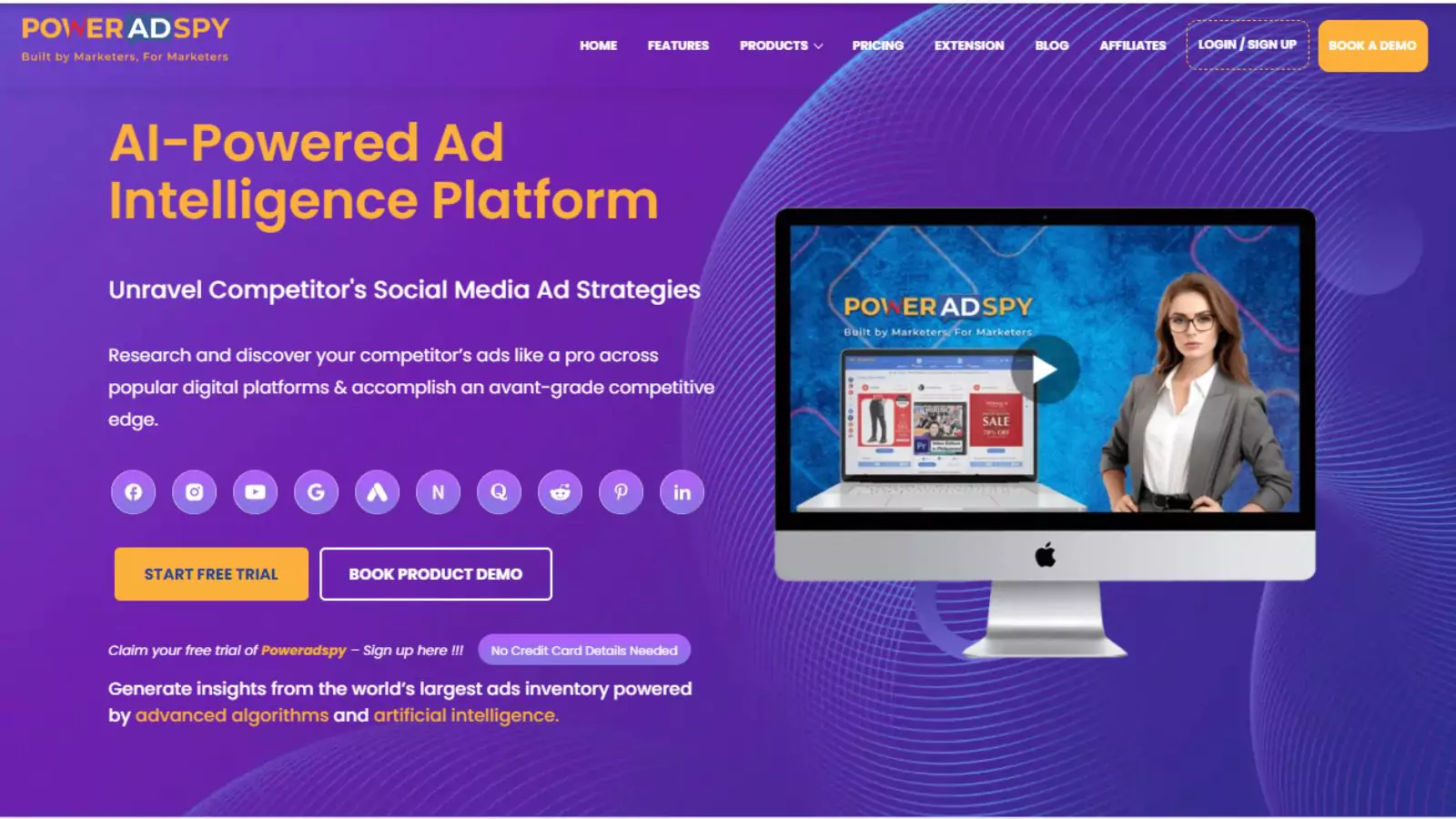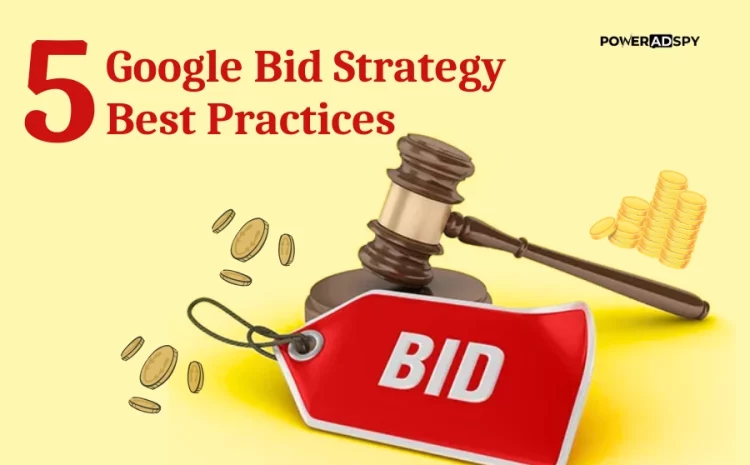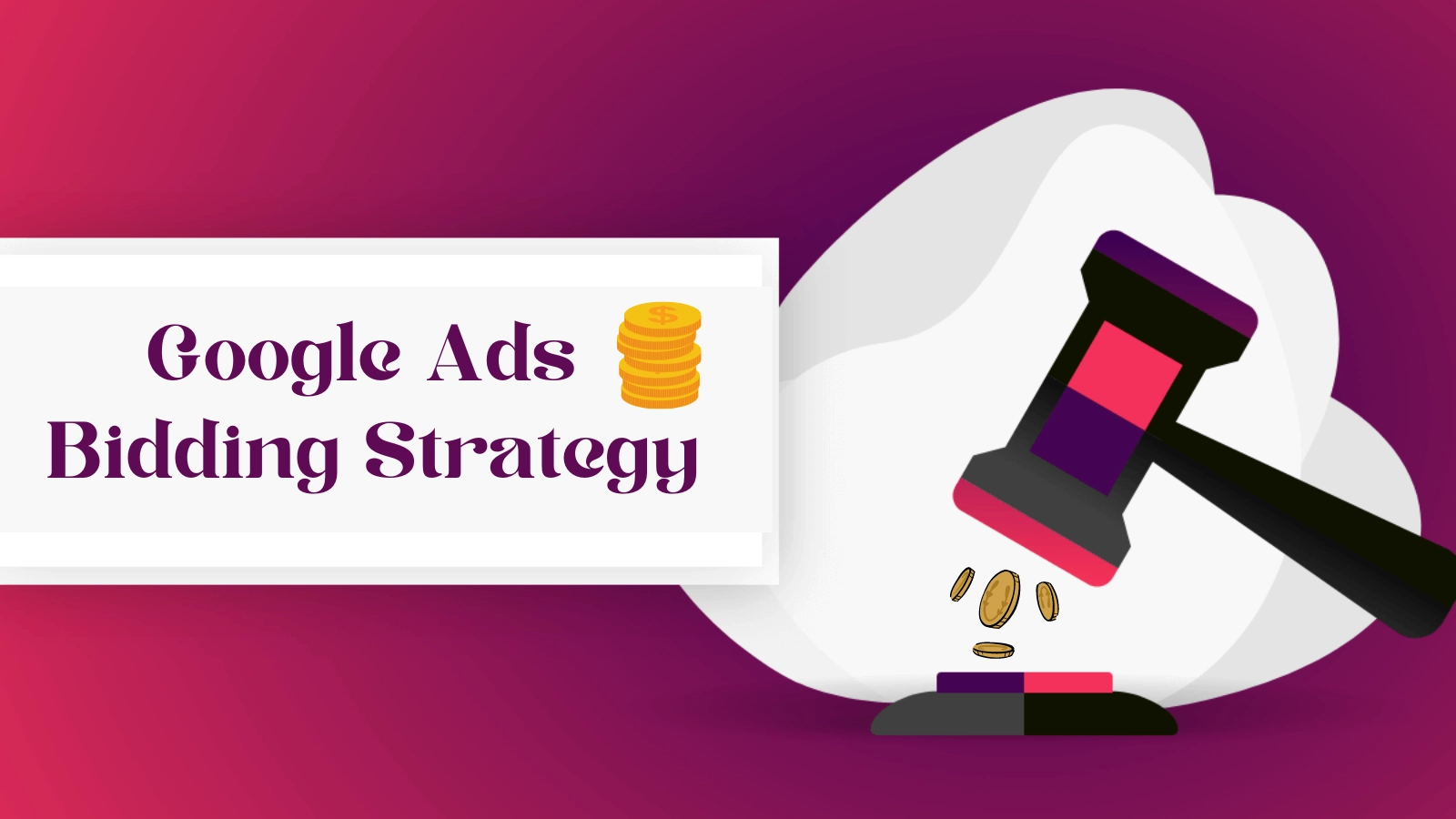5 Powerful Best Practices For Google Bid Strategy in 2024
“Success in bidding lies not just in the bid itself, but in the strategy behind it.”
Having the right Bid strategy is quite crucial when you have decided to invest in an online advertising auction for your PPC campaigning. Whether you overspend or underspend at pay-per-click bidding, you won’t get the desired results for your business.
It means that if you pay more, you have a higher chance of success with your campaigns. But there are also chances that you may overspend, causing you to make losses eventually.
The right Google bidding ad strategy guides your bids to maximize results within your budget. In simple words, it is the game plan that helps you win while staying within your budget.
Understanding your goals, analyzing the competition, and fine-tuning your approach are all part of the game. This strategy is about making informed decisions to achieve the best outcomes for your campaigns.
So, if you’re looking to up your bidding game and increase your chances of success, mastering bid strategy is the way to go. Let’s delve deeper into this essential aspect of online bidding and advertising.
Listen To The Podcast Now!
What Is Google Bid Strategy?
Bid tactics or strategy refers to the approach advertisers use to set bids for their ads on Google Ads, aiming to achieve specific campaign objectives within budget constraints. It encompasses various automated and manual methods, including Manual CPC, Enhanced CPC, Target CPA, Target ROAS, Maximize Clicks, and Maximize Conversions.
The importance of strategy lies in its ability to:
Optimize Performance: Bid strategies help advertisers optimize Google ads, maximize clicks, conversions, or revenue, depending on campaign goals.
Increase Efficiency: Automation streamlines bid management, saving time and resources while improving results.
Enhance ROI: By aligning bids with desired outcomes, bid strategy helps advertisers achieve a better return on investment.
Adapt to Market Changes: Bid strategies can dynamically adjust bids based on real-time data and market conditions, ensuring competitiveness.
Improve Campaign Targeting: Bid strategies enable advertisers to target specific audiences and optimize bids accordingly, enhancing campaign effectiveness.
In essence, strategy for bid is crucial for advertisers seeking to optimize their ad performance, achieve campaign objectives, and maximize the impact of their advertising efforts on Google’s platform.
What Are The Categories Of Bid Strategy?
The three main categories of bid strategies in online advertising are:
Manual Bidding
Advertisers manually set bids for their ads. They determine the maximum amount they will pay for clicks, conversions, or other desired actions. Manual bidding gives advertisers greater campaign control but requires constant monitoring and adjustment to optimize performance.
Automated Bidding
Automated bidding, also known as algorithmic bidding, relies on machine learning algorithms to automatically adjust bids based on various factors such as user behavior, device type, time of day, and more. These strategies include Target CPA (Cost Per Acquisition), Target ROAS (Return on Ad Spend), Maximize Conversions, and Enhanced CPC (Cost Per Click).
Smart bidding
The strategy refers to a subset of automated bidding strategies offered by Google Ads. These strategies use machine learning algorithms to automatically adjust bids in real time based on various factors such as user behavior, device type, location, time of day, and more.
Value bidding
Value-based bidding is a strategy in Google Ads that prioritizes the worth of each conversion over the sheer volume. This automated method fine-tunes bids in real-time, utilizing various indicators to optimize performance. It can be used across a range of campaign types, including search, shopping, display, and video ads.
5 Best Practices For Bid Strategy
Here are some best practices that can help you optimize your campaigns and find the most cost-effective way to reach your goals:
Ensure Your Conversion Tracking Order
It’s crucial to have your conversion tracking set up and running smoothly, as it’s essential to accurately measure and analyze the actions taken by users on your website after interacting with your ads. Your data can consider inaccurate without it. Double-check to ensure your tracking is functioning specifically.
Set Realistic Goals
Understand that PPC campaigns require time to yield results. Start with achievable goals rather than expecting immediate success. Testing and gathering data will refine your strategies over time.
Double-Check Your Attribution Model
Your attribution model should align with your goals and support them. Understand how your campaigns, keywords, and ads contribute to conversions.
Optimize for High-Quality Ad Placements
While there’s no secret recipe, adjusting your bid strategy, improving ad and landing page relevance, narrowing demographics, and testing different ad formats can enhance ad placements.
Understand Your Target Audience
Spend time researching and understanding your target customers’ needs. Use this knowledge to tailor your campaigns effectively, including targeting, copy, and design. Nowadays, marketers have started utilizing Google ad spy tools like PowerAdSpy. It helps brands and marketers to understand the target audience and competitive landscape.
PowerAdSpy is a robust platform for tracking, analyzing, and optimizing social media ads across diverse platforms. With the help of its cutting-edge features, it has helped competitors to understand the ever-evolving competitive arena.
PowerAdSpy- Advanced Ad Intelligence Tool

PowerAdSpy is an advanced ad intelligence tool designed to empower marketers, advertisers, and businesses with comprehensive insights into advertising campaigns across various platforms, particularly in social media.
The following are the core features of PowerAdSpy:
Comprehensive Ad Database
PowerAdSpy provides access to a vast database of social media ads across various industries and niches. It enables users to explore diverse ad creatives and strategies that competitors and leading brands utilize.
Advanced Search Filters
PowerAdSpy provides robust search functionality with filters based on keywords, advertisers, ad types, engagement metrics, and more. It allows users to narrow down results to find specific ads relevant to their needs and interests.
Ad Performance Insights
The tool provides detailed analytics on ad performance, including engagement metrics and estimated reach. It helps in creating effective bid strategy for campaigns. It also assists users identify successful ad campaigns and understanding what resonates with their target audience.
Social Media Platform
PowerAdSpy- a Google display ads spy tool allows marketers and brand to spy on more than ten social media platforms like Pinterest, YouTube, Instagram, Twitter, and more. It allows users to analyze cross-platform advertising strategies and gain insights into competitors’ advertising efforts across multiple channels.
Demographic and Targeting Analysis
PowerAdSpy gives insights into the audience targeting parameters used in ads, including demographics, interests, and behaviors. It also assists users in refining their targeting strategies and understanding competitor audience preferences.
These features together empower marketers and advertisers to gain valuable insights, optimize their ad campaigns, and stay competitive in the ever-evolving landscape of Facebook advertising.
Read More
7 Google Ads Optimization Tips to Boost Your ROI Now
Shape Your Marketing Strategy With Google Display Ads
Target Competitors: 06 best Strategies For Competitive Advertising
Power Of Google Search Ads Strategy: A Complete Guide
7 Google Ads Bidding Strategy
Here is a list of some of the bid strategies that can help you
Target CPA (cost per acquisition):
This bid strategy instructs Google to aim for your desired cost per action (like click, signup, or purchase) or actual acquisition. It is particularly effective for meeting target competitors and generating leads. Leveraging CPA bidding offers several benefits, including targeting conversions (such as signups or mobile app downloads) within your daily budget.
It utilizes conversion tracking data to boost conversions at a reduced cost while steering clear of unprofitable clicks. However, this strategy requires a substantial budget (approximately double your CPA target) to gather the necessary data for optimization.
Recently, Google introduced the option to optimize campaigns for acquiring new customers. For non-branded, non-RSLA campaigns, he is exclusively bidding on new customers. The separation allows us to focus entirely on prospecting, preventing unprofitable spending that might masked by expenses targeting a warm audience. – said Alex Golick.
Target ROAS (return on ad spend):
Target ROAS is an intelligent bid strategy that optimizes campaigns to achieve a specific return on ad spend set by advertisers. Google adjusts bids based on the likelihood of ads reaching the target ROAS. Note that this strategy requires a minimum number of conversions before it becomes available: 15 in the last 30 days for Google Display Network campaigns, 10 per day for App campaigns, 75 conversions in the recent 30 days for Discovery campaigns, and 30 conversions in the last 30 days for Video Action campaigns.
Target ROAS is ideal for eCommerce businesses promoting multiple products to audiences already inclined to make purchases. However, it does not prioritize revenue maximization and focuses solely on achieving a specified return on ad spend.
Maximize conversions:
This bid strategy aims to attain as many conversions as possible within the campaign budget, regardless of the cost per action (CPA). Google adjusts bids based on its algorithms’ predictions of which clicks will lead to conversions. It is suitable for campaigns with conversion tracking enabled and those focused on increasing the conversion rate, as well as for brands operating within a limited budget. Even though this strategy can increase conversions, Google’s algorithm may target individuals most likely to buy, which could exceed the daily budget and might not result in the best price.
Maximize conversion value:
Unlike maximizing conversions, this strategy prioritizes achieving the highest possible conversion value within the campaign budget. Instead of targeting audiences likely to buy, Google aims for audiences likely to purchase valuable items. However, caution is advised as this strategy may lead to overspending, higher conversion costs, and potentially lower advertising ROI.
Maximize clicks:
The maximize clicks bid strategy aims to maximize the number of ad clicks within the campaign budget, making it suitable for campaigns with good conversion performance seeking to reach new audiences or gather more data. It efficiently drives traffic to websites or landing pages; however, not all clicks obtained through this bidding option may be valuable, so monitoring conversion numbers and ROAS is essential to ensure balanced budget allocation.
Maximize CPM (cost per 1,000 impressions):
Maximize CPM focuses on building awareness campaigns by charging an average price for 1,000 impressions. The bidding option is available for Google Display Network ads and YouTube, with charges applicable even if the audience skips the ad.
The Bottom Line
In wrapping up, picking the right bid strategy is a big deal in online advertising. Whether you aim for more conversions, specific returns on ad spend, or just trying to get more clicks, each strategy has its perks and fits different campaign goals. The important thing? Have clear goals and know your audience well.
Keep your bidding straightforward and in line with what you want to achieve. Remember to pay attention to how things are going and tweak your strategy based on performance. That way, you’ll maximize your ad budget and reach your goals.









